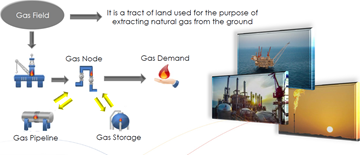Gas Field Class
| Description: | field from which gas is extracted |
| Detail: |
See also Gas Field Property Reference for a detailed list of properties for this class of object.
See the Gas Modelling article for details.
Gas Field
"Gas Field" is a tract of land used for the purpose of extracting natural gas from the ground and it is considered as the main source of gas coming into our system. The obligatory connection of a "Gas Field" object is with a "Gas Node", while the flow from there could take different directions.

Production
"Gas Field" can be toggled off or on within our system using the "Units" property. Additionally, an external injection of gas into the field from external sources or loss of gas from leaks can be represented with the use of "External Injection" property. In case of gas additions, the sign will be positive whereas for leaks it will be negative.
Constraints
The production of gas can be limited in any interval with the use of the "Max Production" property, while a "Target" can be set to reach with a penalty assigned "Target Penalty". Penalty values are making the constraints soft and this gives the flexibility to the algorithm to decide the most cost- efficient approach to solve the problem.
Expansion
The maximum units of "Gas Fields" to be built through the Horizon can be constrained from the "Max Units Built" property, while the maximum built number per year can be adjusted by the "Max Unit Built in Year" property.
Reporting
Some of the most common reporting properties are the "Production" which is defined as the production of the Gas Field in TJ and the "End Volume" which is defined as the volume of gas in the field at the end of the period and is calculated as: End Volume = Initial Volume - Production
Gas Field Cost Curve
In order to create a cost curve at the gas field object the user needs to use multiple bands at the "Production Cost" and "Production Volume" properties. The combination of these properties and the use of different bands will give a cost curve.
